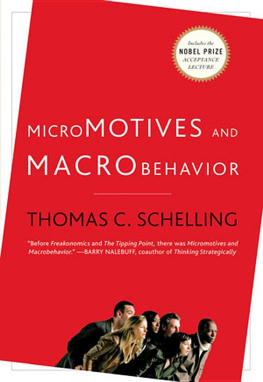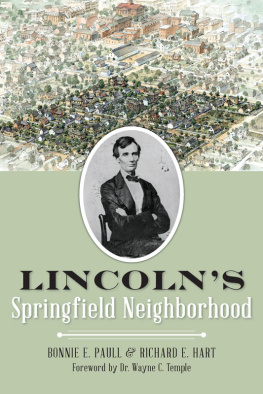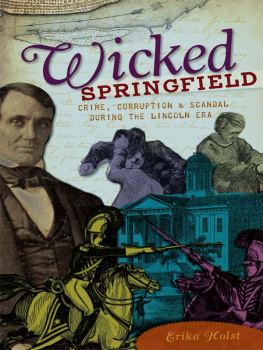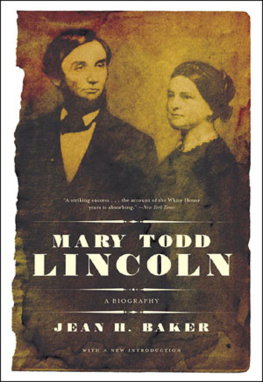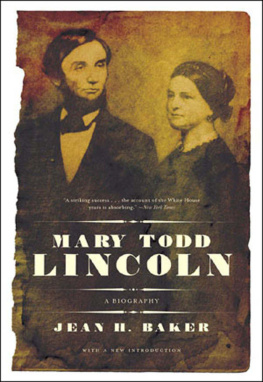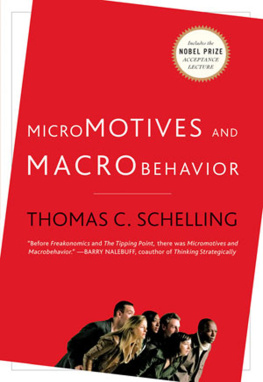The Limits of Organization / KENNETH J. ARROW
Power and the Structure of Society / JAMES S. COLEMAN
The Moon and the Ghetto / RICHARD R. NELSON
Micromotives and Macrobehavior / THOMAS C. SCHELLING
Micromotives and Macrobehavior
with a New Preface and the Nobel Lecture
THOMAS C. SCHELLING

W W NORTON & COMPANY New York London
Copyright 2006, 1978 by W. W. Norton & Company, Inc.
All Rights Reserved
Library of Congress Cataloging in Publication Data
Schelling, Thomas C. 1921
Micromotives and macrobehavior.
(Fels lectures on public policy analysis)
1. Policy sciences. 2. Choice (Psychology).
3. Social choice. 4. Collective behavior. 5. Social
problems. I. Title. II. Series.
H61.S355 1978 301.113 78-17119
W. W. Norton & Company, Inc.
500 Fifth Avenue, New York, N.Y. 10110
www.wwnorton.com
W. W. Norton & Company Ltd.
Castle House, 75/76 Wells Street, London W1T 3QT
ISBN: 978-0-393-07568-7
Contents
Preface to the New Edition
Ive published several books over the years, but I believe that this one was the most fun to write. I was able to explore in print social phenomena that intrigued me then and still do. The decision by W. W. Norton & Company to bring out a new edition suggests that there is an audience that also finds these phenomena interesting.
It has been three decades since I composed Micromotives and Macrobehavior , and I still occasionally pick it up and read a few pages nostalgically. People who read it who do not know me probably have no idea that I am an economist. For this I am pleasedI like to believe that I can present significant ideas without formal models or mathematics. I am still astonished by how many people who have seen the book remember the opening paragraph.
Some readers may know that in 2005 I was awarded the Bank of Sweden Prize in Economic Sciences in Memory of Alfred Nobel and wonder whether this book had anything to do with it. I cannot give a definitive report: the committee that selected me along with Professor Robert Aumann did not cite specific publications. The language of the announcement, however, did say that the prize was for having enhanced our understanding of conflict and cooperation through game-theoretic analysis. Does this book have anything to do with game theory?
I define game theory as the study of how rational individuals make choices when the better choice among two possibilities, or the best choice among several possibilities, depends on the choices that others will make or are making. Clearly, that is what this book is about: interdependent decisions. Some game theorists employ a more restrictive definitionthe mathematical analysis of such decisions. Ive never used much mathematics, so the selection committee evidently did not employ the restricted definition. I did not think of the book as game theory when I wrote it, but I do appreciate that it is easily construed as multi-person game theory, and Chapter 7 I probably would have identified as game theory if it had occurred to me.
Any reader who likes my kind of game theory may be interested in what else Ive written that the selection committee may have adverted to. I suggest The Strategy of Conflict (Harvard University Press, 1960, 1980); it, too, is non-mathematical, it is mostly about two-individual not many-individual situations, and it bears a resemblance to the official Prize Lecture that I gave in Stockholm as a condition for the award. That lecture has been added to the original seven chapters of this book; my editor at W. W. Norton & Company thought it likely that readers would be curious what I chose to talk about in response to the prize.
I am sometimes asked where or how I acquired the ideas that show up in this book. It is not easy to reply. It all happened more than thirty years ago. I think most of my ideas arose from observing behaviors that spiked my curiosity. When those examples show up in the book a reader is likely to think I already had the idea and the example is just an illustration; often the example generated the idea. I illustrate coordination by the example of traffic lights; actually, traffic lights helped me understand coordination. I also use the illustration of a mattress on the highway that jams up the traffic; everyone waits in line to swerve around it, wondering what the trouble is, but when that person finally does swerve around it, he has no incentive to park and remove the mattress. It happened to me.
Actually I think many readers remember the illustrations more vividly than the theory, and the remembered illustration then reminds them how the theory worked. I read of an injury during a hockey game that a helmet would have prevented; the incident helped me understand the incentives toward competitive self-endangering behavior. Readers remember the hockey incident and the principle it embodied. (Today I might have used steroids as my example.)
Micromotives and Macrobehavior was not composed as a book. The first chapter was designed to introduce a book; each of the other chapters was independently motivated and existed before the idea of the book took shape. In the end, though, they all just seemed to fit together. The new final chaptermy Nobel acceptance speechis something Ive been mulling over for half a century; if I were obliged to justify its inclusion I could say that it deals with the evolution of social (international) norms of behavior: decisions to abide by norms tend to strengthen those norms.
I hope that this new edition will be read for another thirty years.
Acknowledgments
When I reflect on it I am surprised at how much of what I write, including things that please me, I write at somebodys invitation. Julius Margolis asked me to use the Fels Lectures to collect some thoughts he knew I was working on; I might have collected them anyway, but I might not, and surely not so soon. Emmanuel Mesthene urged me earlier to put on paper some thoughts he knew I was working on; they are here too, perhaps only because he did. And some parts of this book, like Chapters 2 and 7, were more years getting straightened out than you might believe; if you like them you can thank a number of people who, while contributing ideas in private and in print, were especially generous with their enthusiasm, a nourishment without which I find it hard to work. They are Graham T. Allison, Philip B. Heymann, Mancur Olson, Howard Raiffa, Charles L. Schultze, Edith M. Stokey, A. Michael Spence, and Richard J. Zeckhauser.
If the book reads well it is largely because Joyce Huntley Quelch types superb copy with such speed and good humor, while doing everything else that a secretary does, that I enjoyed the luxury of unlimited revisions.
Parts of Chapters 3 and 4 were in Robin Marris (ed.), The Corporate Society (Macmillan, 1974) and are used here by permission of the President and Fellows of Harvard University. An earlier version of Chapter 5 was in Bela Balassa and Richard Nelson (eds.), Economic Progress, Private Values, and Public Policy (North-Holland Publishing Company, 1977). A longer version of Chapter 7 appeared as Hockey Helmets, Concealed Weapons, and Daylight Saving: A Study of Binary Choices with Externalities, Journal of Conflict Resolution , Vol. 17, No. 3 (September 1973), pp. 381428 and is used here by permission of the publisher, Sage Publications, Inc.
MICROMOTIVES AND MACROBEHAVIOR

